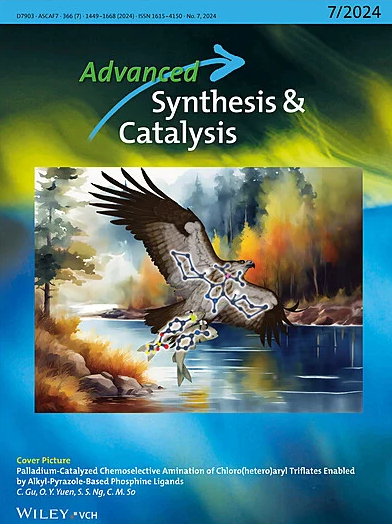利用蓝光和转氨酶开发用于光学活性胺不对称合成的光生物催化氧化还原系统。针对马伐卡滕的案例研究
IF 4.4
2区 化学
Q2 CHEMISTRY, APPLIED
引用次数: 0
摘要
摘要。α-手性胺是光学纯高附加值化学品(包括药品、农用化学品和天然产品)不对称合成的通用构件。在这里,我们报告了一个锅,两步顺序消旋仲醇的光学富集胺通过光生物催化氧化还原胺化线性级联离消旋。首先,在440 nm蓝光led照射下,以9-芴酮为无过渡金属光催化剂,以o2饱和二甲亚砜(DMSO)为反应介质,以原位生成的过氧化氢(H2O2)为猝灭剂,采用可见光光氧化还原催化,将一组外消旋(杂)苯醇近定量氧化为前手性酮。中间体酮进一步转化为相应的非外消旋胺,转化率高达99%,光学纯度(90 ~ 99.9% ee)从高到优;冻干的大肠杆菌细胞分别含有(R)或(S)选择性重组转氨酶(E. coli/TAs),在以吡哆醛-5'-磷酸(PLP)为辅助因子,异丙胺(iPrNH2)为氨基供体的水溶液KPi缓冲液中催化立体选择性还原胺化反应,形成互补的绝对构型。开发的光生物催化体系对外消旋1-苯乙醇(1.0 mmol)进行了放大,得到(S)-(−)-1-苯乙胺的转化率为91%,分离率为82%,ee为99%。所得到的(S)-α-甲基苄胺与6-氯-3-异丙基嘧啶-2,4(1H,3H)-二酮的功能化得到了对映体上富集的新推出的心脏特异性肌球蛋白抑制剂马伐camten,收率为76%,ee为99%。此外,通过单晶x射线衍射(XRD)分析,得到了原料药的第一个晶体结构。本文章由计算机程序翻译,如有差异,请以英文原文为准。
Development of Photo-Biocatalytic Redox System for Asymmetric Synthesis of Optically Active Amines Using Blue Light and Transaminases. A Case Study Toward Mavacamten
Abstract. α-Chiral amines are versatile building blocks for the asymmetric synthesis of optically pure high-added-value chemicals, including pharmaceuticals, agrochemicals, and natural products. Herein, we report a one-pot, two-step sequential deracemization of racemic sec-alcohols to optically enriched primary amines throught a photo-biocatalytic oxidation-reductive amination linear cascade. In the first step, near-to-quantitative oxidation of a set of racemic (hetero)benzylic alcohols into prochiral ketones was accomplished using visible light photoredox catalysis relying on 440 nm blue LEDs irradiation, 9-fluorenone as a transition-metal-free photocatalyst, and O2-saturated dimethyl sulfoxide (DMSO) as the reaction medium and a quencher of the in situ generated hydrogen peroxide (H2O2). The intermediary ketones were further converted into the corresponding non-racemic amines with up to >99% conversion, high-to-excellent optical purity (90−99.9% ee), and complementary absolute configuration via a stereoselective reductive amination catalyzed by lyophilized E. coli cells containing the respective (R)- or (S)- selective recombinant transaminases (E. coli/TAs) in an aqueous KPi buffer in the presence of pyridoxal-5'-phosphate (PLP) as cofactor and isopropylamine (iPrNH2) as an amino group donor. The developed photo-biocatalytic system was scaled up for racemic 1-phenylethanol (1.0 mmol), furnishing (S)-(−)-1-phenylethylamine with 91% conv., 82% isolated yield and 99% ee. An exemplary functionalization of the obtained (S)-α-methylbenzylamine with 6-chloro-3-isopropylpyrimidine-2,4(1H,3H)-dione led to afford an enantiomerically enriched newly launched cardiac-specific myosin inhibitor mavacamten in 76% yield and 99% ee. In addition, a single-crystal X-ray diffraction (XRD) analysis was performed, furnishing the first crystal structure for the titled API.
求助全文
通过发布文献求助,成功后即可免费获取论文全文。
去求助
来源期刊

Advanced Synthesis & Catalysis
化学-应用化学
CiteScore
9.40
自引率
7.40%
发文量
447
审稿时长
1.8 months
期刊介绍:
Advanced Synthesis & Catalysis (ASC) is the leading primary journal in organic, organometallic, and applied chemistry.
The high impact of ASC can be attributed to the unique focus of the journal, which publishes exciting new results from academic and industrial labs on efficient, practical, and environmentally friendly organic synthesis. While homogeneous, heterogeneous, organic, and enzyme catalysis are key technologies to achieve green synthesis, significant contributions to the same goal by synthesis design, reaction techniques, flow chemistry, and continuous processing, multiphase catalysis, green solvents, catalyst immobilization, and recycling, separation science, and process development are also featured in ASC. The Aims and Scope can be found in the Notice to Authors or on the first page of the table of contents in every issue.
 求助内容:
求助内容: 应助结果提醒方式:
应助结果提醒方式:


